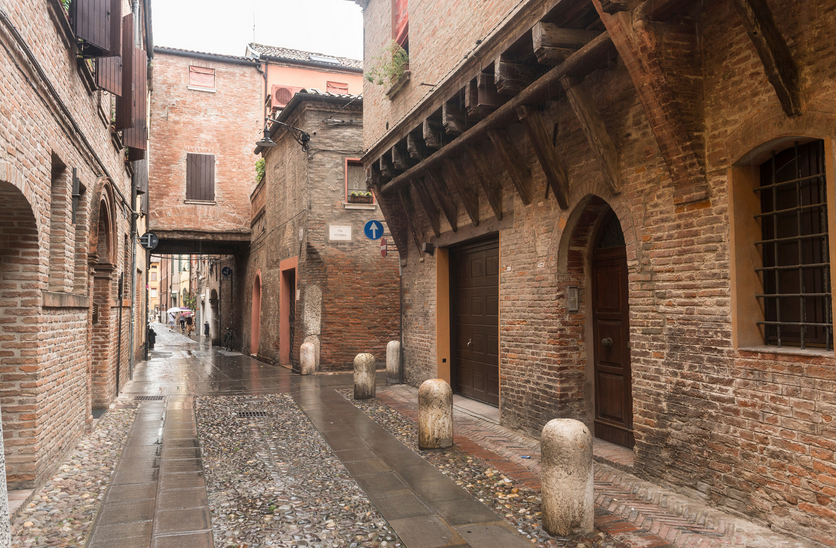THE FERRARESE JEWISH COMMUNITY
The memory of the Jewish Community in Ferrara

The city of Ferrara hosts an important Jewish community as early as the end of the fifteenth century. This is possible thanks to the Estensi's policy which offers them protection and hospitality, making the Court available as a refuge for fugitives of the Jewish people.
This situation is quite short-lived, because due to the Devolution of Ferrara to the Papal State in 1597, everything changes.
In 1624 the construction of the well-known "JEWISH GHETTO" began in the medieval quarter of Ferrara.
On this date there are about 1500 Jews who live in the city, and who are forced to respect the curfew from sunset to dawn, until 1861, the year of the proclamation of the unification of Italy.
Thus began a period of freedom for the Jewish community of Ferrara, which however was cut short after less than a century: in 1938 the terrible persecutions began following the institution of the racial laws, with the subsequent outbreak of the Second World War.
During the war years, most of the assets of the Jewish community were destroyed and seized by the fascists, and the ghetto was sadly put back into operation: about 200 Jews were exiled again. The location of the Jewish Ghetto is exactly between Via Mazzini, Via Scienze, Via Vittoria, Via Contrari and Via Vignatagliata, and it is precisely among these streets that the exiled Jewish community lived until the end of the Second World War.
In Via Vignatagliata there are two plaques in memory of the Philosopher Isacco Lampronti, as well as Rabbi and Doctor who lived in the Jewish Ghetto and became famous for having written a grandiose Talmudic encyclopaedia.
Furthermore, at number 79 there is the medieval building that housed the Jewish School, which was born as a kindergarten and elementary school, but which after the enactment of the racial laws in 1938 was opened to all Ferrara students and teachers of Jewish origin.
THE SYNAGOGUES IN FERRARA
Nowadays only three synagogues remain of the many that were concentrated in the Jewish Ghetto at number 95 in via Mazzini. The building that houses them was purchased by a wealthy Roman banker in 1485, Ser Samuel Melli, who decided to donate it to the Jewish community of the time. The building is still the center of aggregation of the small and active local Jewish community. Inside, the former German Temple, used for ceremonies, and the former Synagogue of the Italian rite, which today offers its large hall for community celebrations and for some conferences, can still be visited and function. At the time, three synagogues of different nature in the same building made it possible for such a large community to perform different rites depending on the origin of the families.
Entering the synagogue door, you immediately notice two marble plaques, which are intended to commemorate the over one hundred deportees and the horrors of racial persecution dating back to the Second World War, which still make us shiver today.
MEIS - NATIONAL MUSEUM OF ITALIAN JEWISH AND SHOAH
In Ferrara there is also the National Museum of Italian Judaism and the Shoah (MEIS), inaugurated in 2017, and located near the historic center, which offers visitors an interactive itinerary dedicated to Jewish history in Italy divided between ancient and recent history, with particular attention to the story of the tragedy of the Holocaust.
The Museum was built within the same complex that housed the former city prisons, the place of imprisonment of anti-fascists and Jews during the war. It is a choice, this, not at all by chance, on the contrary studied ad hoc to make the museum not only a place of narration, but also an emblematic and impactful symbol, bearer of a message of challenge and transformation of the suffering experienced at the time. In this way a place of segregation and exclusion becomes a place of union and inclusiveness.
THE JEWISH CEMETERY
The Jewish Cemetery of Ferrara is the oldest in Emilia-Romagna, located within the city walls, surrounded by greenery, of considerable size, it seems to expand without ever finding a border, it is located at the end of Via delle Vigne.
The Cemetery, then called the Orto degli Ebrei, was purchased by the Jewish Community between the 16th and 17th centuries, but starting from 1598, the year of the Devolution of the Estensi, Ferrara was no longer a place of tranquility and serenity for the Jews, and the new rules imposed by the Papal State forbid public Jewish funerals.
The cemetery was expanded many times over the following centuries, up to the last intervention in 1911, in which the monumental granite entrance designed by the architect Ciro Contini was built.
The famous Ferrarese writer and professor Giorgio Bassani is also buried inside the Jewish Cemetery of Ferrara. by the sculptor Arnaldo Pomodoro and the architect Piero Sartogo.
Strolling in the streets of the Historic Center, where the Jewish community once walked and lived, is magical, almost surreal. Come and visit us, so as not to miss this emotion.
